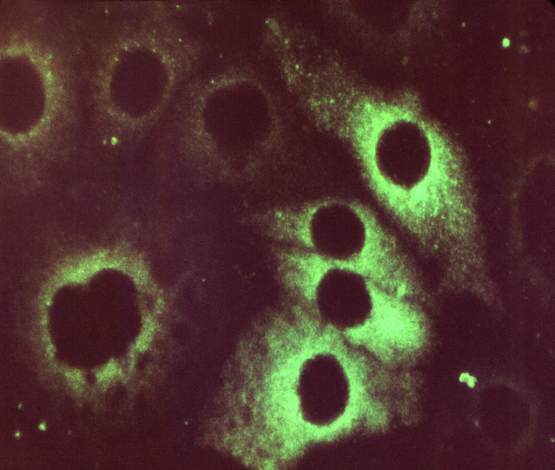TICAM (Toll-interleukin 1 Receptor Domain (TIR)-co ...

Details
Gene name
N/A
Immunoglobulin isotype
IgG
Gene name synonims
N/A
Concentration
N/A
Alternative name4
TICAM
Species reactivity
Mouse
Purification method
Purified
Clonality
Polyclonal
Category
Antibodies
Clone
Polyclonal antibody
Host organism
Host: Rabbit; Source: Mouse
Specificity and cross-reactivity
Recognizes mouse TICAM at ~66kD.
Tested for:
ELISA (EL/EIA), Western Blot (WB)
Form/Appearance
Supplied as a liquid in PBS, 0.05% BSA, 0.05% sodium azide.
Other gene names
TICAM2; TICAM2; TIRP; TRAM; TIRAP3; TICAM-2; MGC129876; MGC129877; TIRAP3; TIRP; TRAM
Alternative name2
TICAM (Toll-interleukin 1 Receptor Domain (TIR)-containing Adaptor Molecule-1, TRIF, Toll/IL-1 Receptor Domain-containing Adapter-inducing IFN-beta)
Alternative name3
TICAM (Toll-interleukin 1 Receptor Domain (TIR)-containing Adaptor Molecule-1, TRIF, Toll/IL-1 Receptor Domain-containing Adapter-inducing IFN-beta)
Alternative name1
Anti-TICAM (Toll-interleukin 1 Receptor Domain (TIR)-containing Adaptor Molecule-1, TRIF, Toll/IL-1 Receptor Domain-containing Adapter-inducing IFN-beta)
Alternative name5
Anti -TICAM (Toll-interleukin 1 Receptor Domain (TIR)-containing Adaptor Molecule-1, TRIF, Toll/IL-1 Receptor Domain-containing Adapter-inducing IFN-beta)
Gene
The Interleukin-1 family (IL-1 family) is a group of 11 cytokines, which plays a central role in the regulation of immune and inflammatory responses to infections or sterile insults. Rec. E. coli interleukin-1 for cell culture or antibody production.
Advisory
In order to retain the quality and the affinity of productone unchanged, please, avoid cycles of freezing and thawing. For antibodies that are in liquid form or reconstituted lyophilized antibodies small amounts could become entrapped on the seal or the walls of the tube. Prior to use briefly centrifuge the vial to gather all the solution on the bottom.
Storage and shipping
Store at 4 degrees Celsius for short term storage.. For long-term storage and to avoid repeated freezing and thawing, add sterile 40-50% glycerol, aliquot and For optimal long term storage, productone should be kept at -20 degrees Celsius. Aliquots are stable for at least 12 months productone should be stored at -20 degrees Celsius.. For maximum recovery of product, centrifuge the original vial after thawing and prior to removing the cap. Further dilutions can be made in assay buffer.
Other names
TIR domain-containing adapter molecule 2; TIR domain-containing adapter molecule 2; TIR domain-containing adapter molecule 2; OTTHUMP00000207407; cytoplasmic adaptor; TRIF-related adaptor molecule; NF-kappa-B-activating protein 502; toll-like receptor adaptor protein 3; putative NF-kappa-B-activating protein 502; toll/interleukin-1 receptor (TIR) domain-containing adapter protein; toll-like receptor adaptor molecule 2; Putative NF-kappa-B-activating protein 502; TRIF-related adapter molecule; Toll-like receptor adaptor protein 3; Toll/interleukin-1 receptor domain-containing protein
Description
productone is a polyclonal antibody of high purity and binding affinity for the antigen that it is risen against. Properly used, this antibody will ensure excellent and reproducible results with guaranteed success for the applications that it is tested in. Polyclonal antibodies have series of advantages - larger batches can be supplied at a time, they are inexpensive to manufacture and respectively to buy, the time needed for production is considerably shorter. Polyclonal antibodies generally are more stable and retain their reactivity under unfavorable conditions. To obtain more detailed information on productone, please, refer to the full product datasheet.
Additional description
Whole adhesion and interacting molecules are present in lysates used as reference for ELISA quantification of these molecules and their subunits.The receptors are ligand binding factors of type 1, 2 or 3 and protein-molecules that receive chemical-signals from outside a cell. When such chemical-signals couple or bind to a receptor, they cause some form of cellular/tissue-response, e.g. a change in the electrical-activity of a cell. In this sense, am olfactory receptor is a protein-molecule that recognizes and responds to endogenous-chemical signals, chemokinesor cytokines e.g. an acetylcholine-receptor recognizes and responds to its endogenous-ligand, acetylcholine. However, sometimes in pharmacology, the term is also used to include other proteins that are drug-targets, such as enzymes, transporters and ion-channels.